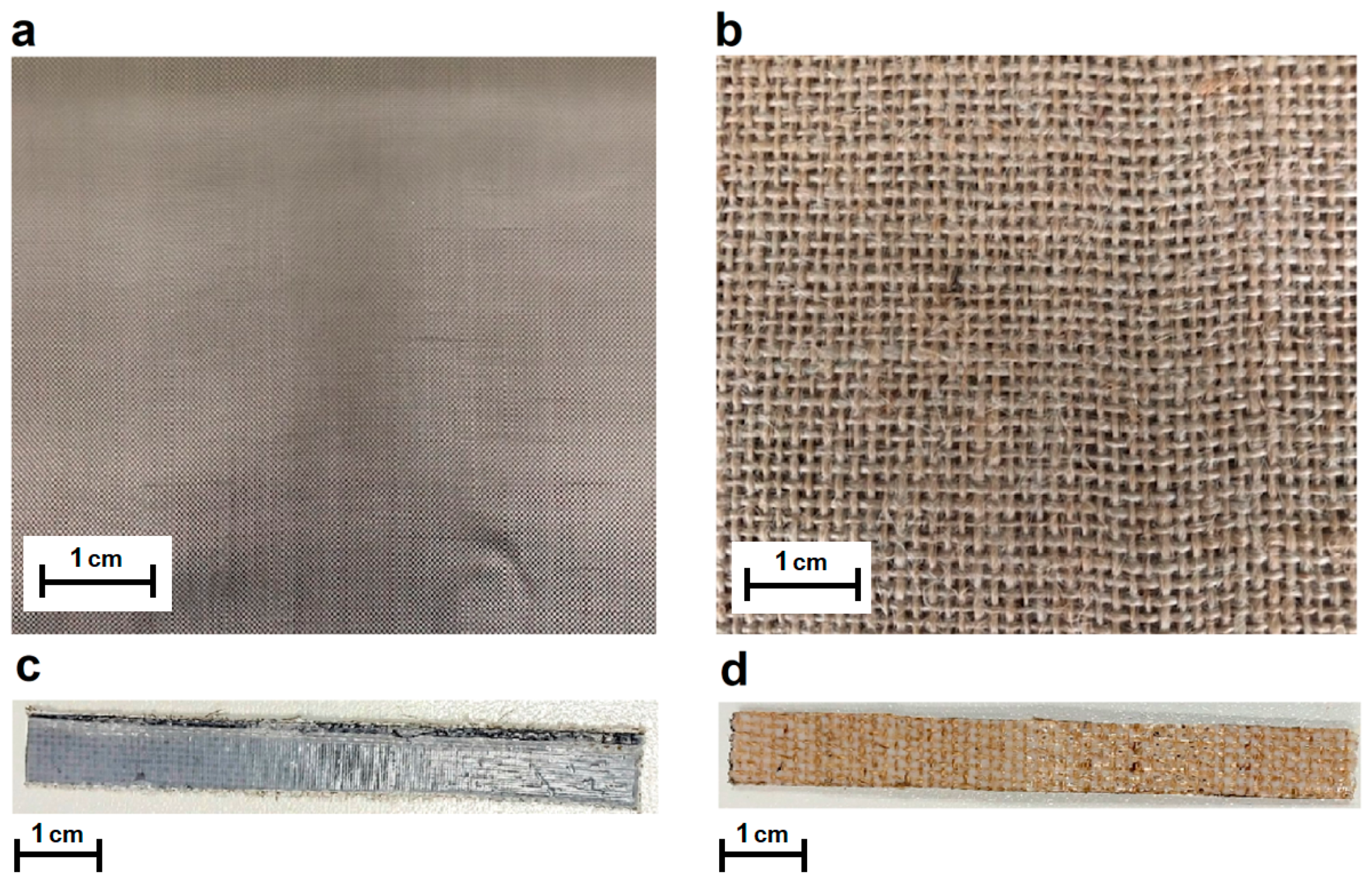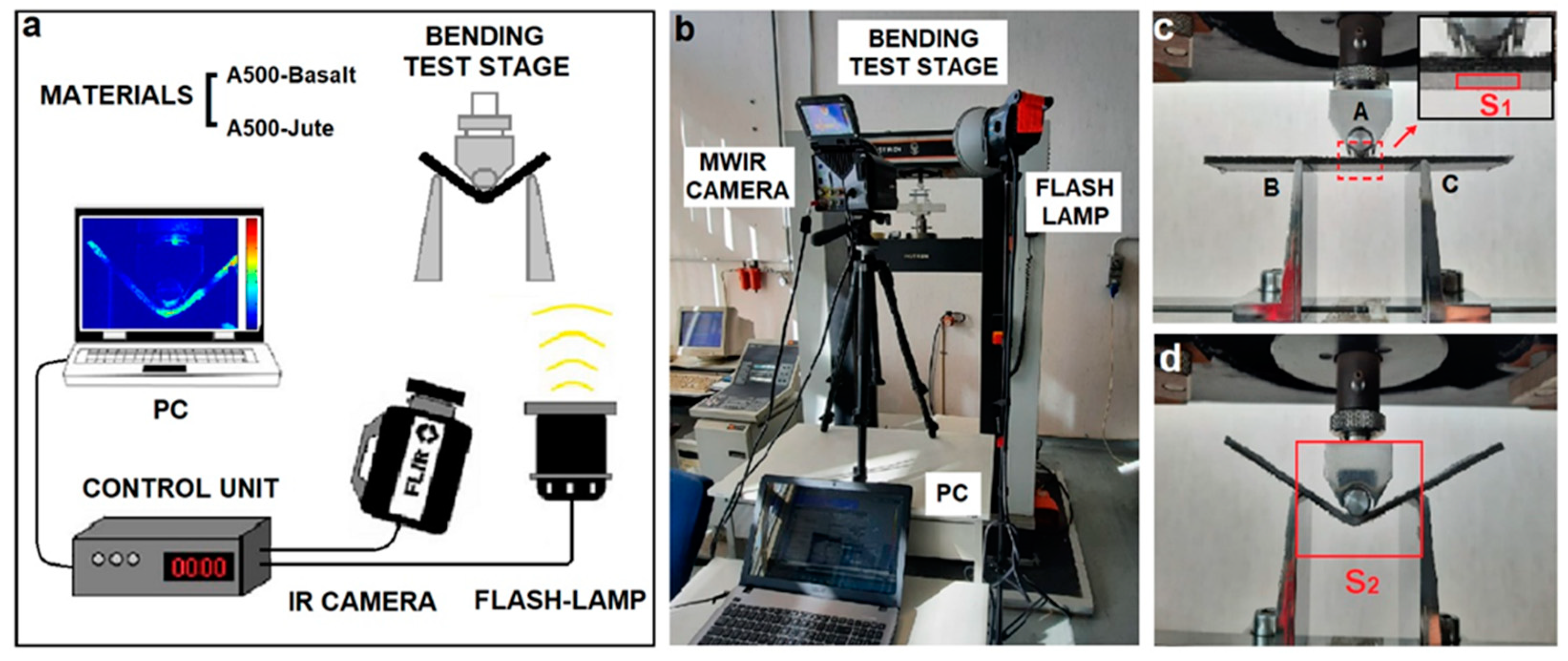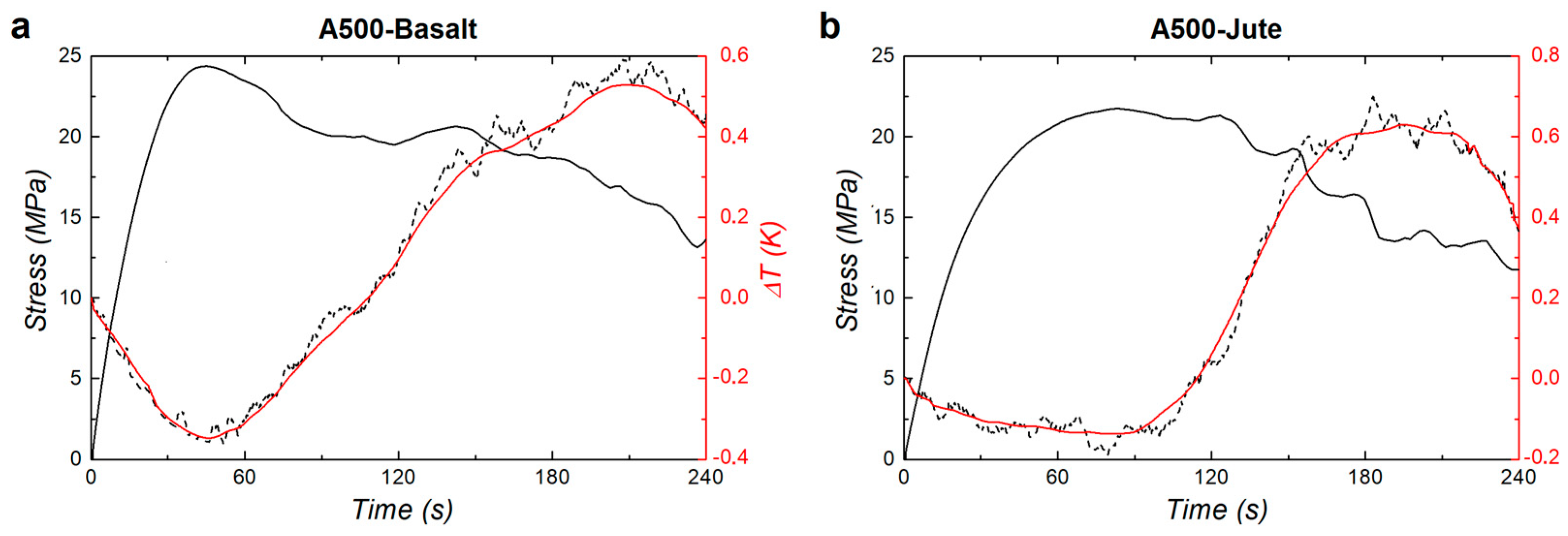Infrared Imaging Analysis of Green Composite Materials during Inline Quasi-Static Flexural Test: Monitoring by Passive and Active Approaches
Abstract
1. Introduction
2. Materials and Methods
2.1. Samples Realization
- A jute fiber fabric plain weave type, with an areal density of 290 g/m2 and supplied by Composite Evolution Ltd. (Chesterfield, UK);
- A plain weave basalt fabric with an areal weight of 210 g/m2 from Incotechnology GmbH (Pulheim, Germany).
- Filming of the A500 blend, preliminarily dried in a vacuum oven at 70 °C overnight, with the aid of a flat die extruder Teach-Line E 20-T equipped with a calender CR 72T Collin (Ebersberg, Germany). The process conditions applied were: a temperature profile of 165°–175°–180°–170°–165° from the hopper to the die, and a screw speed of 60 rpm. Operating in this way, the matrix was transformed in a 100 μm-thick film.
- Film stacking and hot pressing: sample plates were prepared by alternately superimposing A500 film and fiber fabric layers and then consolidated by hot pressing using a lab-press Collin P400E (Ebersberg, Germany) at 180 °C, applying a pre-optimized pressure cycle. Regardless of the nature of the fibers, the process conditions adopted made it possible to obtain laminates with a thickness of approximately 2 mm.
2.2. Inline Infrared Imaging: Set-Up and Measurements
3. Results and Discussion
3.1. Infrared Imaging: Passive Approach
3.2. Infrared Imaging: Active Approach
4. Conclusions
Author Contributions
Funding
Institutional Review Board Statement
Informed Consent Statement
Data Availability Statement
Conflicts of Interest
References
- Park, S.W.; Choi, J.H.; Lee, B.C. Multi-objective optimization of an automotive body component with fiber-reinforced composites. Struct. Multidiscip. Optim. 2018, 58, 2203–2217. [Google Scholar] [CrossRef]
- Guo, P.; Bao, Y.; Meng, W. Review of using glass in high-performance fiber-reinforced cementitious composites. Cem. Concr. Compos. 2021, 120, 104032. [Google Scholar] [CrossRef]
- Rajak, D.K.; Pagar, D.D.; Menezes, P.L.; Linul, E. Fiber-Reinforced Polymer Composites: Manufacturing, Properties, and Applications. Polymers 2019, 11, 1667. [Google Scholar] [CrossRef] [PubMed]
- Li, M.; Pu, Y.; Thomas, V.M.; Yoo, C.G.; Ozcan, S.; Deng, Y.; Nelson, K.; Ragauskas, A.J. Recent advancements of plant-based natural fiber–reinforced composites and their applications. Compos. Eng. 2020, 200, 108254. [Google Scholar] [CrossRef]
- Tadele, D.; Roy, P.; Defersha, F.; Misra, M.; Mohanty, A.K. A comparative life-cycle assessment of talc- and biochar-reinforced composites for lightweight automotive parts. Clean Technol. Environ. Policy 2020, 22, 639–649. [Google Scholar]
- Lotfi, A.; Li, H.; Dao, D.V.; Prusty, G. Natural fiber–reinforced composites: A review on material, manufacturing, and machinability. J. Thermoplast. Compos. Mater. 2021, 34, 238–284. [Google Scholar] [CrossRef]
- Wang, B.; Zhong, S.; Lee, T.L.; Fancey, K.S.; Mi, J. Non-destructive testing and evaluation of composite materials/structures: A state-of-the-art review. Adv. Mech. Eng. 2020, 12. [Google Scholar] [CrossRef]
- Gholizadeh, S. A review of non-destructive testing methods of composite materials. Procedia Struct. Integr. 2016, 1, 50–57. [Google Scholar] [CrossRef]
- Maldague, X.P. Theory and Practice of Infrared Technology for Nondestructive Testing, 1st ed.; Wiley-Interscience: New York, NY, USA, 2001; 704p, ISBN 978-0-471-18190-3. [Google Scholar]
- Rippa, M.; Pagliarulo, V.; Lanzillo, A.; Grilli, M.; Fatigati, G.; Rossi, P.; Cennamo, P.; Trojsi, G.; Ferraro, P.; Mormile, P. Active Thermography for Non-invasive Inspection of an Artwork on Poplar Panel: Novel Approach Using Principal Component Thermography and Absolute Thermal Contrast. J. Nondestruct. Eval. 2021, 40, 21. [Google Scholar] [CrossRef]
- Planinsic, G. Infrared thermal imaging: Fundamentals, research and applications. Eur. J. Phys. 2011, 32, 1431. [Google Scholar] [CrossRef]
- Meola, C.; Carlomagno, G.M.; Bonavolontà, C.; Valentino, M. Monitoring Composites under Bending Tests with Infrared Thermography. Adv. Opt. Technol. 2012, 2012, 720813. [Google Scholar] [CrossRef]
- Usamentiaga, R.; Venegas, P.; Guerediaga, J.; Vega, L.; Molleda, J.; Bulnes, F.G. Infrared thermography for temperature measurement and non-destructive testing. Sensors 2014, 14, 12305–12348. [Google Scholar] [CrossRef]
- Vavilov, V.P.; Burleigh, D.D. Review of pulsed thermal NDT: Physical principles, theory and data processing. NDTE Int. 2015, 73, 28–52. [Google Scholar] [CrossRef]
- Sfarra, S.; Perilli, S.; Paoletti, D.; Ambrosini, D. Ceramics and defects: Infrared thermography and numerical simulations—A wide-ranging view for quantitative analysis. J. Therm. Anal. Calorim. 2016, 123, 43–62. [Google Scholar] [CrossRef]
- Rippa, M.; Mormile, P. Active thermography to detect defects in wood samples of interest for cultural heritage. In Proceedings of the 2nd European NDT & CM Days, Prague, Czech Republic, 4–7 October 2021; (ENDT Days 2021). Available online: https://www.ndt.net/search/docs.php3?id=26491 (accessed on 7 October 2021).
- Ishimwe, R.; Abutaleb, K.; Ahmed, F. Applications of thermal imaging in agriculture—A review. Adv. Remote Sens. 2014, 3, 128–140. [Google Scholar] [CrossRef]
- Rippa, M.; Ambrosone, A.; Leone, A.; Mormile, P. Active thermography for real time monitoring of UV-B plant interactions. J. Photochem. Photobiol. Biol. 2020, 208, 111900. [Google Scholar] [CrossRef]
- Rippa, M.; Battaglia, V.; Cermola, M.; Sicignano, M.; Lahoz, E.; Mormile, P. Monitoring of the copper persistence on plant leaves using pulsed thermography. Environ. Monit. Assess. 2022, 194, 60. [Google Scholar] [CrossRef]
- Cunningham, P.R.; Dulieu-Barton, J.M.; Dutton, A.G.; Shenoi, R.A. Thermoelastic characterization of damage around a circular hole in a GFRP component. In Key Engineering Materials; Trans Tech Publications Ltd.: Stafa-Zurich, Switzerland, 2001; Volume 204–205, pp. 453–463. [Google Scholar]
- Paynter, R.J.H.; Dutton, A.G. The use of a second harmonic correlation to detect damage in composite structures using thermoelastic stress measurements. Strain 2003, 39, 73–78. [Google Scholar] [CrossRef]
- Donadio, F.; Ferraro, P.; Lopresto, V.; Pagliarulo, V.; Papa, I.; Rippa, M.; Russo, P. Response of glass/carbon hybrid composites subjected to repeated low velocity impacts. J. Compos. Mater. 2022, 17, 2789–2802. [Google Scholar] [CrossRef]
- Zalameda, J.N.; Horne, M.R. Real time detection of damage during quasi-static loading of a single stringer panel using passive thermography. In Thermosense: Thermal Infrared Applications XL; SPIE: Philadelphia, PA, USA, 2018; p. 106610H. [Google Scholar] [CrossRef]
- Meola, C.; Boccardi, S.; Boffa, N.D.; Ricci, F.; Simeoli, G.; Russo, P.; Carlomagno, G.M. New perspectives on impact damaging of thermoset- and thermoplastic-matrix composites from thermographic images. Compos. Struct. 2016, 152, 746–754. [Google Scholar] [CrossRef]
- Meola, C.; Boccardi, S.; Carlomagno, G.M. Infrared thermography to inline monitoring of glass/epoxy under impact and quasi-static bending. Appl. Sci. 2018, 8, 301. [Google Scholar] [CrossRef]
- Harizi, W.; Chaki, S.; Bourse, G.; Ourak, M. Mechanical damage assessment of Glass Fiber-Reinforced Polymer composites using passive infrared thermography. Compos. Eng. 2014, 59, 74–79. [Google Scholar] [CrossRef]
- Leone, G.; D’Angelo, G.A.; Russo, P.; Ferraro, P.; Pagliarulo, V. Plasma treatment application to improve interfacial adhesion in polypropylene-flax fabric composite laminates. Polym. Compos. 2022, 43, 1787–1798. [Google Scholar] [CrossRef]
- Russo, P.; Papa, I.; Pagliarulo, V.; Lopresto, V. Polypropylene/Basalt fabric laminates: Flexural properties and impact damage behavior. Polymers 2020, 12, 1079. [Google Scholar] [CrossRef]
- Zhang, Z.F.; Xin, Y. Mechanical properties of basalt-fiber-reinforced polyamide 6/polypropylene composites. Mech. Compos. Mater. 2014, 50, 509–514. [Google Scholar] [CrossRef]
- Boccardi, S.; Carlomagno, G.M.; Meola, C.; Russo, P.; Simeoli, G. Remote inline monitoring of thermal effects coupled with bending stresses of glass fibres composites. Compos. Eng. 2019, 174, 107042. [Google Scholar] [CrossRef]
- Ghosh, S.; Singh, S.; Maity, S. Thermal Insulation Behavior of Chemically Treated Jute Fiber Quilt. J. Nat. Fibers 2021, 18, 568–580. [Google Scholar] [CrossRef]
- Li, Z.; Ma, J.; Ma, H.; Xu, X. Properties and Applications of Basalt Fiber and Its Composites. IOP Conf. Ser. Earth Environ. Sci. 2018, 186, 012052. [Google Scholar] [CrossRef]
- Meola, M.; Boccardi, S.; Carlomagno, G. Infrared Thermography in the Evaluation of Aerospace Composite Materials; Woodhead Publishing: Cambridge, UK, 2015; ISBN 978-1-78242-171-9. [Google Scholar]
- Wu, D.; Busse, G. Lock-in thermography for nondestructive evaluation of materials. Rev. Générale Therm. 1998, 37, 693–703. [Google Scholar] [CrossRef]
- Ibarra-Castanedo, C.; Maldague, X. Pulsed phase thermography reviewed. Quant. Infrared Thermogr. J. 2004, 1, 47–70. [Google Scholar] [CrossRef]





Disclaimer/Publisher’s Note: The statements, opinions and data contained in all publications are solely those of the individual author(s) and contributor(s) and not of MDPI and/or the editor(s). MDPI and/or the editor(s) disclaim responsibility for any injury to people or property resulting from any ideas, methods, instructions or products referred to in the content. |
© 2023 by the authors. Licensee MDPI, Basel, Switzerland. This article is an open access article distributed under the terms and conditions of the Creative Commons Attribution (CC BY) license (https://creativecommons.org/licenses/by/4.0/).
Share and Cite
Rippa, M.; Pagliarulo, V.; Napolitano, F.; Valente, T.; Russo, P. Infrared Imaging Analysis of Green Composite Materials during Inline Quasi-Static Flexural Test: Monitoring by Passive and Active Approaches. Materials 2023, 16, 3081. https://doi.org/10.3390/ma16083081
Rippa M, Pagliarulo V, Napolitano F, Valente T, Russo P. Infrared Imaging Analysis of Green Composite Materials during Inline Quasi-Static Flexural Test: Monitoring by Passive and Active Approaches. Materials. 2023; 16(8):3081. https://doi.org/10.3390/ma16083081
Chicago/Turabian StyleRippa, Massimo, Vito Pagliarulo, Francesco Napolitano, Teodoro Valente, and Pietro Russo. 2023. "Infrared Imaging Analysis of Green Composite Materials during Inline Quasi-Static Flexural Test: Monitoring by Passive and Active Approaches" Materials 16, no. 8: 3081. https://doi.org/10.3390/ma16083081
APA StyleRippa, M., Pagliarulo, V., Napolitano, F., Valente, T., & Russo, P. (2023). Infrared Imaging Analysis of Green Composite Materials during Inline Quasi-Static Flexural Test: Monitoring by Passive and Active Approaches. Materials, 16(8), 3081. https://doi.org/10.3390/ma16083081






